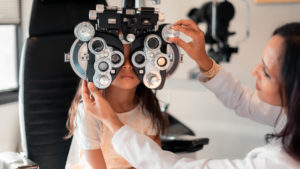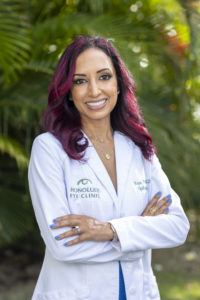January 17, 2022
By Rupa Wong, MD
I receive so many questions daily from parents, even other physicians, who are worried about their children’s myopia. GMAC’s campaign helped me address those questions on a broader scale and reach myopic patients – and their parents – beyond my practice.
Myopia management is personal for me. Aside from my professional experience as a pediatric ophthalmologist, I’m also a mom to three kids (aged 8, 10, and 12 years old). My husband has high myopia, and many in his family have suffered retinal detachments. Ensuring that my children do not have to succumb to the same ocular fate is extremely important to me. It’s why I was the first eye care provider in the state of Hawaii to start treating myopia back in 2014 and have given numerous talks to my colleagues to start using these modalities as well.
So, when the Global Myopia Awareness Coalition (GMAC) contacted me with their ideas for increasing awareness of myopia management on social media, I knew I wanted to participate. While I had never worked with the organization before, GMAC provides invaluable education on myopia and the available treatments to both practitioners and patients. Because myopia is one of my passions, I was one hundred percent on board with their mission.
Creating Conversations Among Parents
I am committed to educating parents about the myopia management treatment options available for their children. Parents want to know what they can do to help negate the effects of increased near work and decreased time outdoors. I receive so many questions daily from parents, even other physicians, who are worried about their children’s myopia. GMAC’s campaign helped me address those questions on a broader scale and reach myopic patients – and their parents – beyond my practice.
I think it’s extremely important to involve parents early on in the decision-making process for their children’s myopia. That starts with laying the foundation of accurate information prior to the patient arriving in our clinic. If the parents are familiar with the concept that progressive myopia is not inevitable, then they are much more open to discussing the options.
Spreading the Word About Myopia Management
I have taken a multi-prong approach to increasing the myopia management side of my practice. I’ve given talks and sent letters to referring pediatricians so that they’re aware that treatment options now exist to help their patients. I created a myopia quiz, which is available on my website, for parents to assess the level of risk – minimal, moderate, or high – that their child has of developing myopia based on lifestyle and family history questions. We also have an excellent protocol in place for educating existing patients in our practice by sending out email blasts with links to my YouTube videos and blog posts on the topic. I also post regularly on Instagram and TikTok about myopia management, and I get so many teens asking me about these treatments on TikTok. I love that they want to be involved in their eye health.
These posts from the GMAC campaign are also beneficial to other eye care professionals. No matter which social media platform they frequent, they’re able to access these posts and share them to their own profiles. This further expands the reach of these efforts, and spreads the message of myopia management to more patients, parents, and practices across the country.
Encouraging Eye Care Professionals to Get on Board
There’s truly no downside to serving our patients to the best of our ability. I have a lot of ophthalmologists who tell me that they don’t have enough time to offer myopia management or that their patients won’t pay for out-of-network services. That’s making the decision for your patient, which is ultimately doing them a disservice. While I think any practice could benefit from offering myopia management, for practitioners who don’t offer these treatments, as eye care professionals, we have an obligation to know the options for our patients and refer them to those doctors who provide myopia management care.

Dr. Wong says that keeping parents informed about myopia management is critical to creating awareness.
I want every parent who has a child with myopia to be knowledgeable about treatment options, whether or not they choose to pursue them. The worst thing a parent could tell me is that they had no idea a certain treatment option was available to their child. I take the time to educate patients and their parents both inside and outside the office.
In sharing this information on social media, it draws even more attention and awareness to this important topic from both a practitioner and consumer perspective. This is a critical component of getting more eye care professionals on board to start offering myopia management to their patients, while it also helps bridge the gap with parents to help them start thinking about what a myopia management treatment plan for their child could look like.
 |
Dr. Rupa Wong is a board certified pediatric ophthalmologist, wife, mom to three kids, entrepreneur, and the managing partner of Honolulu Eye Clinic for the past 13 years. She has been featured on the Best Doctors Lists since 2010 and was featured on the cover of Honolulu Magazine for that issue. She also serves as Clinical Associate Professor at University of Hawaii School of Medicine. Dr. Wong also founded a women’s medical conference, Pinnacle Conference, and a membership site, The Attending Lounge, dedicated to empowering female pre-meds, med students, and residents. Her non-profit work exemplifies her commitment to children in the community, as well as medical education, and includes serving on the Board of Directors for Big Brothers Big Sisters Hawaii, Project Vision, and the Association for Healthcare in Social Media, for which she was a Founding Member. |















